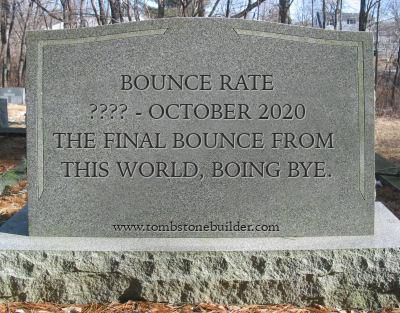RIP bounce rate. The bounce wasn’t long for this world, finally saying goodbye last year.
As you may have heard, Google has put down this beloved metric of many a client with GA4 carrying on as if it never existed.

Who or what was bounce rate?
A bounce on a webpage was counted when a user would land on a page and do nothing.
Well, at least on the web page, they could be making tea for all the analytics server knows. And it doesn’t.
A bounce session duration is counted as if the person was on site for 0 seconds. This is because of a lack of a second data point – nothing triggered, nothing found. Were they even there?
The rate comes into play when you take the number of these ghostly web visits and divide them by all sessions, giving a percentage.
All the single pages, all the single pages
A high bounce rate is only ‘bad’ if you want users to visit more than one page. Which is often the case. What is a good bounce rate? You could try this free tool, once an essential, now a relic left to age on the internet until the domain name runs out. Logan Mastrianna, of datadrivenu.com fame, shares in his informative post that bounce rate can often not mean very much. It doesn’t tell you what the user was really doing or why:
- A bounce happening isn’t necessarily bad. Maybe the user already got all the information they needed.
- A non-bounce isn’t necessarily good. Maybe the user was frustrated by having to click on several pages to find what they were looking for.
Bounce rate was also entirely dependent on the type of page. For example, a high bounce rate of 75% on a blog post would actually mean that your blog post is engaging enough that 25% went to a different page afterwards. That’s what I like to call a soft conversion. Or again it could mean that someone landed on a blog page when they were expecting something completely different (and left). Or it could mean that they read the page for a solid fifteen minutes…
The good news is that you won’t have to worry about bounce rate anymore on GA4. It’s gone, dead, done, dusted.
A new bouncing baby metric is born
No more single sessions, only engaged sessions from now on. Not quite the inverse of bounce rate, this metric has three different ways of validating an engaged user.
| Engaged Session | ||
Lasted 10 seconds or longer | Had 1 or more conversion events | 2 or more page views |
This is way more lenient than bounce rate, as a user could be idle on a webpage for over 10 seconds and still count as an engaged user. A user could even accidentally click on a page twice… maybe not as likely. Seems like engaged sessions could be the dawn of a slightly more informative age now that bounce rate has been laid to rest.
As with all metrics, it’s easy to get fixated on one in isolation but it’s best to look at multiple metrics together to get a clearer picture of what is actually happening on your site.
With that, bounce rate, please do go gently into that good night. Do you think bounce rate went to metric heaven or hell? Probably went to metric purgatory.




